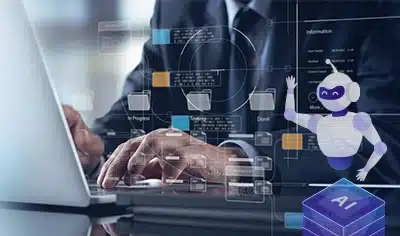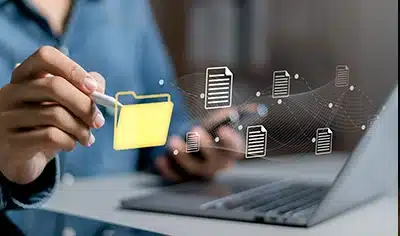Application modernization is crucial for businesses looking to adapt to technological advancements, foster innovation, and become future-ready. Replacing outdated, legacy systems with agile, modern platforms increases efficiency, reduces tech debt, improves scalability, minimizes long-run IT maintenance costs, enhances competitive edge, and much more. While the benefits are undeniable, the application modernization journey is often fraught with a significant hurdle – data migration.
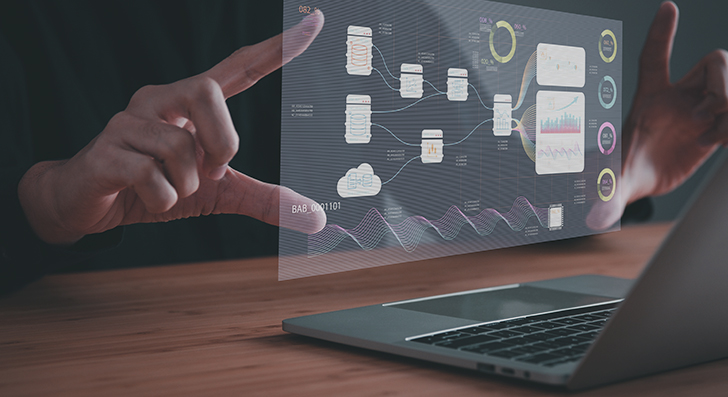
Data migration is important for modernizing legacy applications and helps in dealing with technical debts. According to recent McKinsey reports, as much as 71 percent of the business impact is derived from technology. Companies pay an additional 10-20 percent on top of the cost of any project to address their technical debts. This figure is worth considering, especially when many businesses need to modernize applications if they wish to stay competitive.
However, data migration is rarely straightforward. Moving vast volumes of data from traditional systems to modern platforms while maintaining accuracy and integrity is a complex and daunting task. A single misstep results in information loss, business downtime, and operational disruptions, jeopardizing the modernization project and day-to-day business operations. To navigate these challenges, professional data migration services are indispensable. In this blog, we will cover everything you need to know about application modernization, including data migration challenges and their solutions.
Table of Contents
1. Overcoming the Data Migration Challenges
2. Crafting an Effective Application Modernization Strategy
3. Key Components of an Application Modernization Strategy
Overcoming the Data Migration Challenges
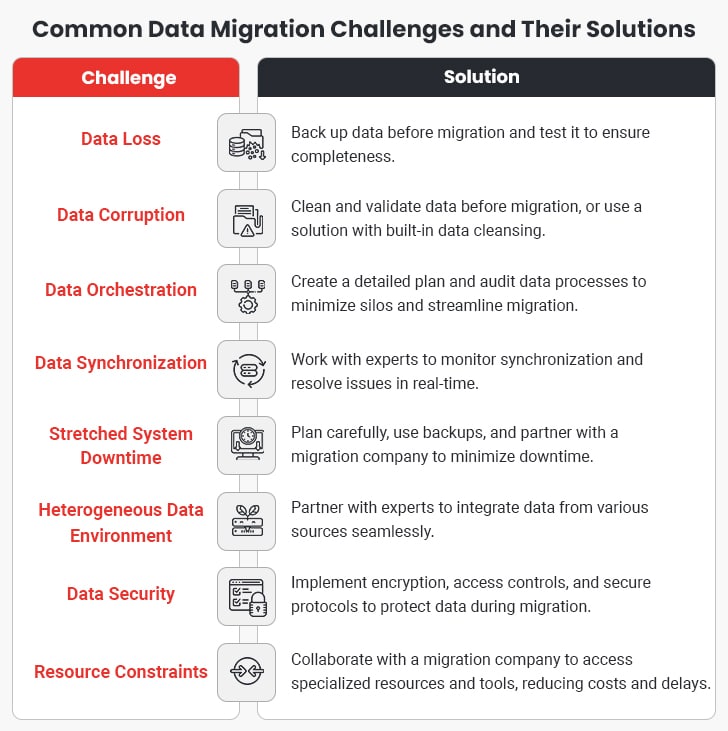
Take a look at some of the significant challenges that businesses face during application modernization when it comes to data migration. Also listed are the solutions to overcome them:
Challenge #1: Data Loss
Data loss occurs during the data transfer process as some parts of it might not be transmitted due to reasons like—hardware or software failures, format incompatibilities, network interference, security measures including access controls, or firewalls, etc. As a result, businesses might lose their critical information irreversibly.
Solution: Data migration companies always take a backup of your data before beginning the transfer process. You can retrieve the information easily using the backup source if anything goes wrong. The professionals thoroughly test the migrated data to ensure that all the data migrated to the new location and is preserved. Thus, you can still use your old data for analysis and reporting.
Challenge #2: Data Corruption
Legacy systems often have huge volumes of data accumulated over the years. This implies that they would have an enormous amount of transactional data spread over multiple databases. However, not all of this data is fit for consumption. Migrating incorrect, redundant, inconsistent, or useless data can have a detrimental effect on the application, adversely impacting the performance of the target system.
Solution: Performing data clean-up and validation procedures before migration can help prevent bugs and system errors. Or else, investing in a data migration solution that also incorporates data cleansing is a smarter way to ensure a smooth and error-free data transfer.
Challenge #3: Data Orchestration
Data can be complex and diverse, residing across multiple platforms and formats. This is especially true in bigger organizations, where multiple disconnected teams are working, or when technical teams and functional teams leverage the same data in plenty of ways. Siloed data complicates the task, making it difficult to extract and consolidate information from disparate sources without disrupting current operations. Consequently, data migration might also be incomplete.
Solution: Having a meticulous data migration plan that is also aligned with business processes can help overcome this challenge. Auditing all the data-related processes and keeping track of data points can help in reducing the number of data silos, streamlining the entire migration project.
Challenge #4: Data Synchronization
Data synchronization is necessary to dodge off problems that might arise due to data inconsistency between the legacy and modern systems. If not handled properly, desync between the two systems can lead to information loss and inappropriate resource utilization. This not only results in budget overruns but also causes reputational damage.
Solution: Well-acquainted with the nitty-gritty of data migration during the application modernization process, an experienced service provider knows what it takes to ensure a seamless data transfer. They continuously monitor the transfer process to ensure that the data syncs perfectly between the old and new systems and fix the issues immediately as and when they arise.
Challenge #5: Stretched System Downtime
Business continuity is critical. However, migration projects can bring about system downtime that might extend than usual, impacting this continuity and user access. Stakeholders might lose opportunities and insights as data stops being collected during this process.
Solution: Minimizing business downtime and disruptions while ensuring zero data loss requires careful planning, robust data security protocols, and reliable backup solutions. And, if businesses lack the resources, partnering with a reliable data migration company is a smarter option. Having the right blend of skills and experience, they offer minimal downtime or near-real-time data replication to minimize disruptions.
Migrate Your Data with Zero Downtime
Challenge #6: Heterogeneous Data Environment
Every data landscape and almost every application is unique. Modern data environments are diversified as new applications often have to integrate data from numerous sources, including legacy systems, third-party applications, and cloud platforms. This heterogeneity can make data migration complex and requires specialized tools and expertise.
Solution: Data migration services providers are acquainted with the intricacies of data migration and can offer integration tools and expertise necessary to ensure a hassle-free and seamless integration between the migrated data and the new application. They also make sure that the target system can be integrated with other tools that you use; for example, CRM, marketing tools, finance tools, ERP, etc.
Challenge #7: Data Security
Security is paramount during the migration process as data is most vulnerable and exposed to third parties. In another instance, it can be a case that your legacy system is more prone to risks and susceptibilities than the target system. Thus, ensuring the integrity and confidentiality of sensitive data is vital for businesses, especially the ones operating in highly regulated industries such as finance or healthcare.
Solution: Employing robust data encryption capabilities, access control, secure transfer protocols, and other such data security measures can help safeguard sensitive information during migration and at rest. Additionally, building a data security strategy as a vital part of the data migration process to fortify important information can help minimize the associated risks.
Challenge #8: Resource Constraints
Ensuring an error-free and hassle-free data migration during application modernization is an uphill task. Specialized skills, expertise, and tools are needed to successfully navigate through the complexities of this process. Leveraging inadequate tools and a lack of in-house resources leads to inefficiencies, delays, and increased project costs.
Solution: Consider collaborating with a data migration company that helps you overcome application modernization challenges and assists you with a seamless transition. You get the dual benefits of access to diversely skilled resources while saving significantly on costs.
Crafting an Effective Application Modernization Strategy
A successful application modernization journey begins with a well-thought-out strategy. Without a clear roadmap, the process can become overwhelming, leading to inefficiencies, unexpected costs, and potential failure. An effective strategy ensures that businesses achieve their modernization goals while minimizing disruptions. Business Requirements for an Application Modernization Strategy
Embarking on an application modernization project is a bold undertaking. To set the stage for success, it’s essential to adopt a strategic framework that addresses the basics:
- What: First, identify which applications are sluggish, hard to update, or struggle to integrate with modern technologies. These systems should be prioritized for modernization.
- Why: Investigate the driving forces behind modernization. Is it the shifting market landscape, increasing competition, or the impact on revenue and market share? Outdated applications might be holding your business back, and modernization can serve as a catalyst, helping you outpace competitors.
- How: Modernization can revolutionize your business, but the approach must be meticulous. Assess available budgets, allocate the necessary resources, select the right tools, and encourage a culture of innovation. Additionally, consider collaborating with an expert in modernization to ensure a smooth transition.
Key Components of an Application Modernization Strategy
The success of any application modernization effort rests on a thoughtfully designed strategy. To yield the desired results, the plan must be anchored in robust principles.
Here are the essential components that form the backbone of a modernization strategy:
-
Business Logic
Consider your business logic as the core of your application. It’s the result of years of refinement and isn’t something you can afford to discard.
How do you ensure this vital component is preserved and integrated?
The answer lies in equipping your team to redesign and adapt the business logic for the cloud using contemporary programming languages and APIs. However, this step is often complex and time-intensive, requiring specialized skills that many organizations may not possess in-house.
-
Data Access
There’s a saying, “Old databases never truly disappear.” Yet, relying on outdated database systems restricts your application’s potential.
Modern databases offer the ability to run applications in the cloud, improve scalability, and cut down on licensing expenses.
Still, transitioning to updated databases isn’t straightforward. It necessitates rewriting data access code, which often requires close collaboration between seasoned developers and fresh talent—which demands time and resources.
-
User Experience/User Interface (UX/UI)
Today’s users expect seamless, intuitive, and platform-independent experiences. Interfaces originally designed for desktop use are no longer sufficient.
Building a modern and engaging UX/UI often means starting from the ground up. This requires designers who focus on user-centric design principles and developers proficient in implementing cutting-edge UX/UI practices.
However, finding the right experts to bring these capabilities to your application modernization solutions introduces additional challenges and complexities.
-
Security
Older applications often functioned safely behind firewalls, with minimal exposure to external threats.
The shift to cloud environments changes everything. Both application-level and infrastructure-level security now demand significant attention.
Does your team possess the necessary skills to implement comprehensive cloud security protocols?
If not, bringing in specialized professionals may become essential, as overlooking security can result in critical vulnerabilities.
-
Cloud Deployment
Moving applications to the cloud requires a unique skill set. Factors such as scalability, redundancy, and load balancing need to be carefully addressed.
Applications deployed in the cloud may experience rapid global adoption, necessitating infrastructure capable of supporting that growth. This makes expertise in managing DevOps and leveraging cloud-based tools indispensable.
Steps to a Successful Application Modernization Strategy
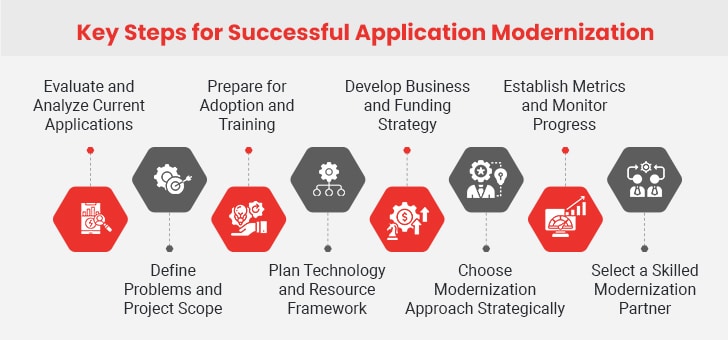
Recognizing the need for an application modernization strategy is a significant step. But how do you go about transforming your applications?
The path ahead is promising, though it may come with complexities and challenges.
Here are the key steps to take for a successful application modernization journey:
1. Evaluate and Analyze
Start with a thorough assessment of your current applications. Consider these questions:
- What strengths does your legacy system offer?
- Are you targeting modernization or aiming for a more comprehensive digital transformation?
- Which applications should be prioritized for redevelopment?
- Are there critical security or compliance concerns that need addressing?
- Do certain applications directly affect customer experiences?
- How many applications in your portfolio need updating?
- What objectives are you aiming to achieve?
As you work through this assessment checklist, incorporate user feedback and compare your applications against industry standards.
2. Identify Problems and Define Project Scope
What’s the core issue you’re addressing? Is it slow performance, outdated features, or security vulnerabilities? Clearly articulate the problem.
Define the project scope by pinpointing functionalities, systems, or features requiring improvement. Also, consider creating a comprehensive project scope document. This will act as a guide, ensuring all stakeholders are aligned on the goals and objectives.
3. Prepare for the Adoption of Modernization and the Learning Curve
Modernizing legacy applications may present a learning curve for your team. To ease this transition, offer the necessary training and support.
Why is this crucial?
Employees often develop preferences for certain technologies and tools, so introducing new technologies and processes might cause disruptions, if not handled properly.
To ensure a smooth integration of new technologies, consider these application modernization strategies:
- Provide sufficient resources and training
- Time the transition carefully
- Foster clear and transparent communication
- Encourage active engagement
4. Plan the Technological and Resource Framework
Choose development platforms, tools, and infrastructure that align with the goals of your project. Evaluate internal and external resources, and craft a comprehensive roadmap for the tools and technologies needed for the modernization process.
Ensure that the selected tools integrate seamlessly with automated application modernization solutions, making tasks like re-architecture, refactoring, or rewriting more efficient. Consider adopting technologies such as microservices and containerization to streamline the process.
5. Develop a Business Plan and Funding Strategy
At this stage, use the insights you’ve gathered to create a comprehensive business plan. This plan should clearly outline the expected outcomes and benefits of the application modernization initiative. Additionally, you should estimate the potential return on investment (ROI) and determine the required budget.
However, funding for application modernization differs from typical IT budgeting. Such initiatives have inherent uncertainties that must be incorporated into your budget estimates.
To gain support from key decision-makers, effectively communicate the value that application modernization strategies bring to the organization, which will help secure the necessary funding and executive endorsement.
6. Choose and Plan the Modernization Approach
Now, it’s time to select the modernization strategy that best fits your goals. There are several application modernization strategies to consider:
- Rehosting (Lift and shift)
- Refactoring (Code enhancement)
- Rearchitecting (Redesigning for the cloud)
- Rebuilding (Starting anew)
Whatever method you opt for, ensure that you have the necessary expertise and planning to safeguard the security of your applications and cloud-based data.
7. Establish Success Metrics and Monitoring Plans
Set specific success metrics to evaluate the effectiveness of your modernization plan.
Identify key performance indicators (KPIs) such as improved application performance, cost reductions, or higher user satisfaction. Implement comprehensive monitoring and tracking systems to measure progress in real-time and make informed decisions based on data.
Ongoing monitoring ensures that your modernized applications don’t become outdated. Similarly, continually benchmarking and measuring results helps you stay on track toward achieving your goals and objectives.
8. Select the Right Modernization Partner
While your internal teams, like chief architects and project managers, will play vital roles, they might not have the specialized skills needed for the transformation.
Partnering with a skilled modernization expert helps prioritize tasks, reduce confusion, and keep the project on track. They also help you overcome application modernization challenges.
Choosing the right partner requires careful research and due diligence. Ensure that the partner has the required expertise and experience for your unique project needs.
Bottom Line
Data migration is an opportunity to enhance operational efficiency, improve data quality, unlock the full potential of modernized applications, and get rid of legacy systems. And the key to navigating the data migration challenges during application modernization lies in acknowledging the challenges and implementing a well-structured approach. Leveraging the expertise of a professional provider acts as a catalyst in this process, providing invaluable resources to mitigate risks and challenges, ensuring a seamless transition to a modern, data-driven future



